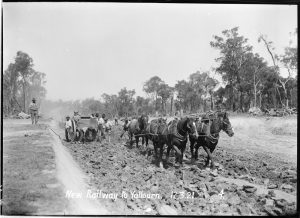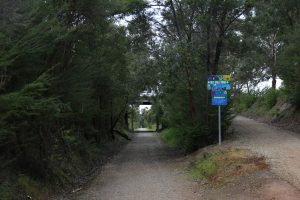History of the Yallourn broad gauge railline
A brief history of the Yallourn broad gauge rail line from 1922 – 1986.
 The beginning of the rail for Yallourn’s industrial needs:
The beginning of the rail for Yallourn’s industrial needs:
From 1920 and planning Yallourn the planners knew they’d need a rail and worked towards this goal. Excess briquettes made in Yallourn were shipped via train to Melbourne. It was such an efficient that in 1953 Victoria was used as an example to Queensland who has black coal which is easier to create power generation without the need for briquettes.
The line originally passed through Hernes Oak diverting off the main Gippsland line starting in 1922 until 1955. A broad gauge track, in Victoria is a 1600mm track width. There also was a smaller 900mm gauge line that serviced between the mines, stations and briquette factories.
From 1922 until 1931 passengers were able to go directly by train through the spur to Yallourn. As of August the 10th, 1931 an announcement lacking a reason was declared that goods trains would continue, however, passengers could only go as far as Moe or Morwell.
Queen Elizabeth II visited Yallourn by train in 1954, via the loop at Herne’s Oak from heading north from the Gippsland line. This was one of the special occasions passengers were allowed on the line since 1931 when passenger trains were no longer regularly traveling on it.
 The Moe – Yallourn route selected
The Moe – Yallourn route selected
An act of Victorian Parliament passed in 1948 called the Moe – Yallourn Railway construction act. Work commenced in 1949, however, there were issues with finding labour that delayed the completion until September 1953. The Moe – Yallourn train line had been a suggestion prior to 1930.
As it reduced the grade to 1 in 110 from the 1 in 50 grades that were experienced over the Haunted Hills. The line was electrified in 1955 until it was banned in 1978. The overhead wires removal began in 1979. The path the Moe – Yallourn rail trail takes is from the second line that was completed in September 1953 and utilised until 1978. The line was officially decommissioned in 1986.
Briquettes and coal were sent by road as well starting in the 50’s as the cost became cheaper than rail.


 The Moe – Yallourn route selected
The Moe – Yallourn route selected